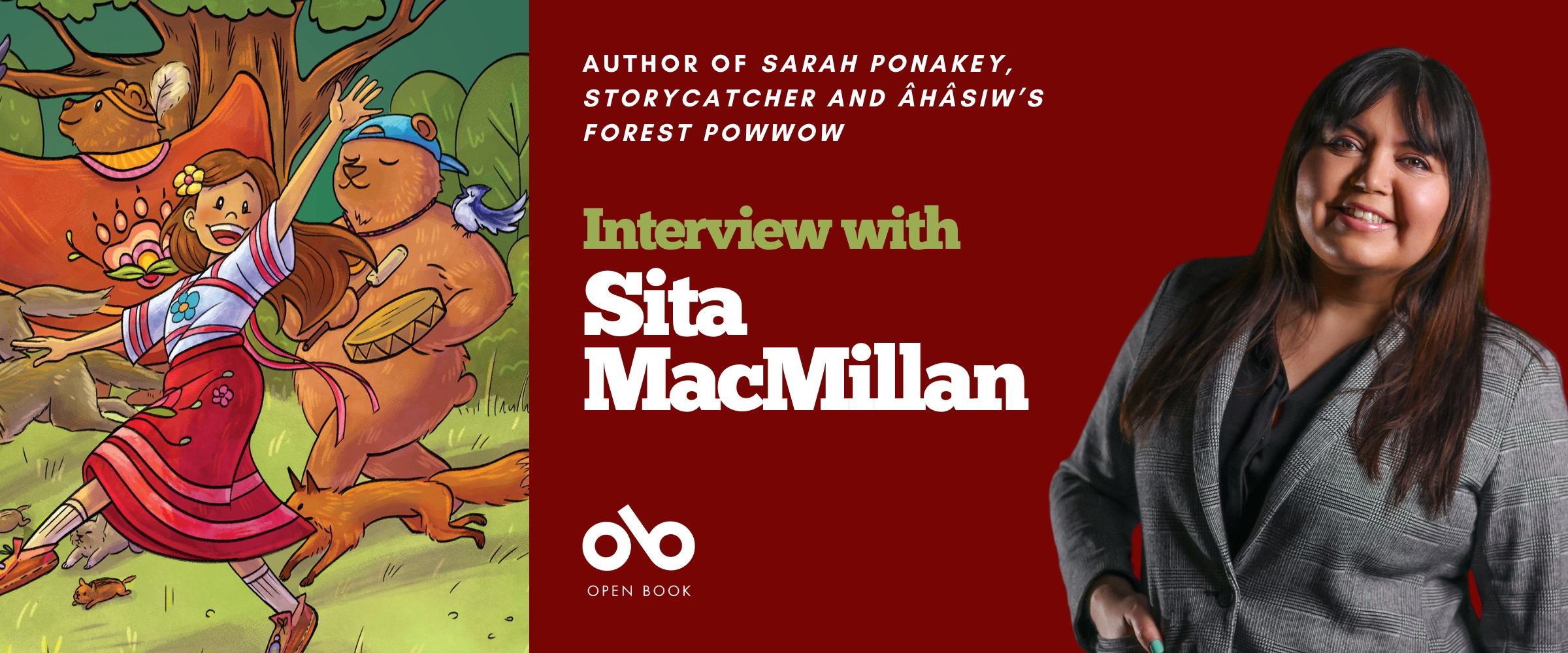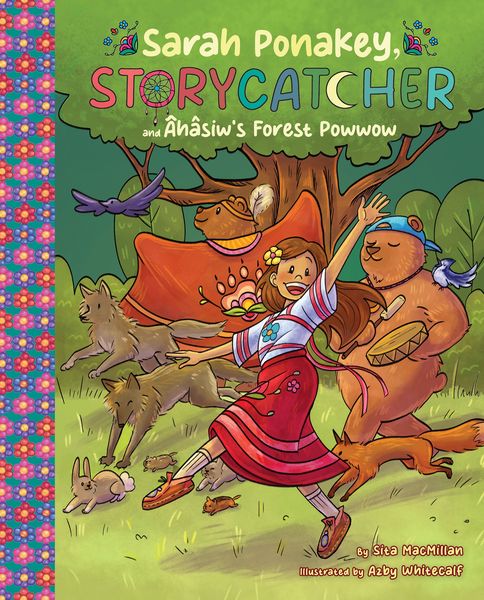Author Sita MacMillan Begins an Essential Series Starring Sarah Ponakey, Storycatcher
It's often the case with young readers, and writers, that they simply do not see the stories that they would like to read and write being published with frequency. This is a distinct problem in CanLit that a number of talented authors are remedying as we speak.
One of those authors is Sita MacMillan, a member of the Zagime Anishinabek nation, who couldn't find children's books that focused on urban Indigenous living. As a result, MacMillan set out to write her own series of picture books that would tell these stories.
Her vibrant debut, Sarah Ponakey, Storycatcher and Âhâsiw’s Forest Powwow (Annick Press), is the first title in that series. In this instalment, Sarah Ponakey has moved to the city with her mother and deeply misses her home community. She stay in touch with friends by writing letters, and tries her best to acclimatize to her new surroundings, but has a really tough spell when she almost loses Âhâsiw, her favourite stuffed animal.
When her mom brushes this off, Sarah transports herself to a magical forest powwow, when she is met by a life-sized Âhâsiw in full regalia, and soon there are joined by a host of woodland creature that all contribute to the celebration. During the event, Sarah realized that she can connect with her Cree culture anywhere, no matter how far she is from her home nation.
Open Book has a great Kid's Club Interview today with the author of the Sarah Ponakey, Storycatcher series, and we're delighted to share it with our readers!
Open Book:
Tell us about your new book and how it came to be.
Sita MacMillan:
Sarah Ponakey Storycatcher and Ậhâsiw’s Forest Powwow is my debut book and the first book of a mini-series. I had written it as a picture book when my children were little then it developed into this wonderful early reader series! As a new mother I was looking for books that were based on urban Indigenous living. So along came Sarah. She was inspired by myself growing up away from community and starting my journey with my children to learn more about our Indigenous culture. While growing up in British Columbia I attended local powwows and community events learning about local customs and traditions. As I entered university I began working and connecting more with Indigenous culture, and asking questions about who I am as a mixed Cree person living away from community. This series came out of this need to make sure that my children saw themselves in a book where we can have big feelings, ask questions, AND know we have so many amazing people to help us along the way. As a past educator my interests have always been in the importance of emotional literacy, which I hope shows throughout each of these books.
OB:
Did the book look the same in the end as your originally envisioned it when you started working, or did it change through the writing process?
SM:
It had started off as a picture book! My children were quite young at the time, and I had envisioned this beautiful picture book with a very similar story. I had never written a picture book before, but I read a lot of them. So, I bravely decided to take the first steps in writing my first children’s picture book. I had the support from writing friends I made along the way and an amazing writing group in Penticton, BC, who helped me gather the courage to go for it. When my Editor Stephanie reviewed my manuscript and after some work we had decided to make it into an early reader series. What a dream come true. Sarah would be able to continue her adventures beyond one book and the images I had once dreamed up became a reality through the beautiful illustrations by Azby Whitecalf.
Your CanLit News
Subscribe to Open Book’s newsletter to get local book events, literary content, writing tips, and more in your inbox
OB:
What do you need in order to write – in terms of space, food, rituals, writing instruments?
SM:
I love to write in a noisy spot! I find hearing people talking around me helps me focus. So, a lot of the early parts of the manuscript were written in a coffeeshop, until we moved across the country. In our new house which is in a more rural spot I was able to create a writing space for me to be in. Instead of the bustling of a coffeeshop, I listened to music or shows in the background while I wrote. I missed the public spaces, but it still worked out well.
I also always need to have a cup of tea (with lots of cream. LOTS of cream some may say). I really like having tea mugs that are handmade, so my cups of tea are usually in beautiful ceramic mugs where I met the maker. One of my favourites is a white ceramic mug a friend made with a golden moon phase. Unfortunately, it recently broke.
Along with my tea, I often lit a candle and would watch its shadow dance against the wall while I sat to think about what to write next…
OB:
How do you cope with setbacks or tough points during the writing process? Do you have any strategies that are your go-to responses to difficult points in the process?
SM:
I didn’t realize how real imposter syndrome was until I began this series. I envisioned these books for children to ask questions about their culture and move through the discomfort by taking brave steps forward with the support of friends and family. What I didn’t realize was that I too would be feeling similar as the writer. I had to move through the worry of asking questions about the language I didn’t grow up with, but I desired my children an earlier opportunity to. I wanted a book where we can talk about the magic of life and the lessons we learn in a safe space, so I was doing that with conversations with family and friends along the way too. These books, although I was doing a lot of writing alone, I never accomplished in solitude. Many conversations happened along the way to keep me going and helped me through the tough points!
Also, while I was working on the first book, Prince Edward Island was hit with Fiona, a post-tropical storm with hurricane like winds and rain, and that was an intense storm to go through. I had to take a break to focus on what was happening in our reality. This very scary time was met with kindness and support from others, and I knew it would take some time to process and be able to continue writing. To help through this very tough time I spent time with my children to make sure they felt safe as we worked through what had happened as a family, community, province and country.
OB:
What's your favourite part of the life cycle of a book? The inspiration, writing the first draft, revision, the editorial relationship, promotion and discussing the book, or something else altogether? What's the toughest part?
SM:
My favourite parts of the life cycle of the book are the inspiration and the editorial relationship between myself and Stephanie, my Editor.
There is something about taking the time to daydream. I would find inspiration in between small moments of quiet in between raising three very young children. I thought about the crows that I saw in Vancouver who would always sit and caw at us. I now live on an island where they are all over once again. I love hearing them calling out. Where I currently live there is a crow downtown that sounds like it is saying hello to me. I had my inspiration from dreams and thoughts I had about what it would be like to grow up and be in Sarah’s world. Where she has such magical experiences and can let her big feelings be there and still take big steps towards following her dreams and seeking answers. She is so brave in a world where she doesn’t feel so comfortable. I am inspired by my children as I witnessed them learn how to walk, talk, and navigate life with such bravery and determination.
Another favourite part has been the editorial relationship with my Editor Stephanie! I am so glad she read my early manuscript and took a chance. I really felt heard by Stephanie as I spoke about the direction of Sarah’s adventures. I envisioned that we would have several magical adventures with Sarah as she learned about her culture and Stephanie helped make this happen. We had a lot of great conversations as the book developed from picture book to an early reader mini-series. Whenever I felt stuck or uncertain I knew Stephanie would be there to talk it out. I couldn’t have asked for a better editor to work with on my debut book. It can be quite an emotional rollercoaster and I am so glad she’s been there alongside me and Sarah’s adventures. Hai Hai, Thank you.
OB:
What are you working on now?
SM:
I am currently working on the third book of the Sarah Ponakey, Storycatcher series! I can’t believe how much has been happening over the last few years with Sarah. Her magical adventures continue as she learns more about who she is within the big world, with, of course, the help of some amazing friends and family along the way! I am also a little sad because I know it’s the last of the mini-series. I have been learning so much while writing this series and growing alongside Sarah within each of the books. I knew I wanted to write a book for most of my life but the act of doing it is so much more emotional than I could have ever imagined. I have learned so much about the art of storytelling and publishing with my Editor. I am so very grateful that Annick Press supported this dream and helped bring Sarah into the world for you all to enjoy.
______________________________________________
Sita MacMillan is a registered member of Zagime Anishinabek and is of a mixed Cree and Scottish background. As a mother to three daughters, Sita was struggling to find children’s books based on urban Indigenous living. This became the inspiration for her debut children's book series, Sarah Ponakey, Storycatcher. She lives with her family in Prince Edward Island.







